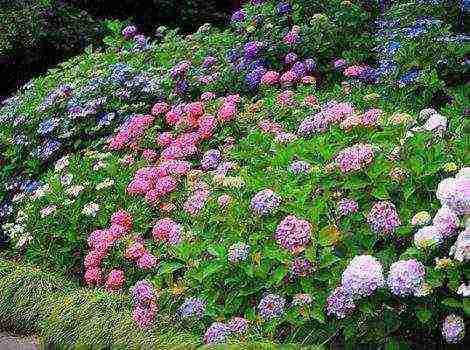Content
- 1 Planting seeds
- 2 Further care of seedlings
- 3 Growing hyacinths in pots
- 4 Reproduction
- 5 Useful video
- 6 How to grow hyacinths outdoors
- 7 Description of hyacinth
- 8 Features in the cultivation of hyacinths in the open field
- 9 Hyacinths: planting and care in the open field
- 10 Hyacinth care after the growing season
- 11 Growing hyacinth from seeds
- 12 Pests and diseases
Gourmet hyacinth is a bulbous plant, therefore it is bred mainly with bulbs. However, you can also grow a beautiful flower from seeds. This method is mainly used when they want to experiment with breeding new varieties.
Planting seeds
You can germinate seedlings both in the garden bed and in some container. The soil into which the seeds will be sown is best prepared from approximately equal parts of turf, peat and sand. It is also necessary to provide the planting site with good drainage.

Seeds are sown in the grooves rather densely (at the rate of 150-200 seeds per square meter) and shallow. The depth of the seed should not exceed 1.5-2 centimeters, otherwise the seedlings will not sprout.
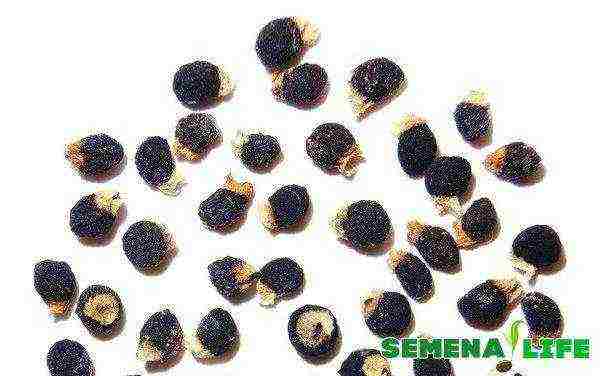
The most suitable time for planting is the beginning of autumn, while seedlings will appear only next spring. The planted seeds must go through a vernalization period, so it is best to store the container in a cool place in winter, sometimes with moderate moisture. If the planting is made in an open area, then the garden bed for the winter is covered with a 20-centimeter layer of compost, hay or similar mulch.
On a note! Hyacinth seeds ripen in capsules that form when the flowers fade.
For their preparation, light yellow unopened boxes are chosen, dried for several days and collected dry seeds in paper bags. Store in a cool dry place before sowing.
The first shoots that appear after 5-6 months do not touch, because the plants are very weak and not rooted. They only need to provide:
- Periodic weeding
- Regular moderate watering
- Loosening the topsoil
- Protection against mechanical damage
- Sufficient but not direct sunlight
- Top dressing (you can use superphosphates, ammonium nitrate)
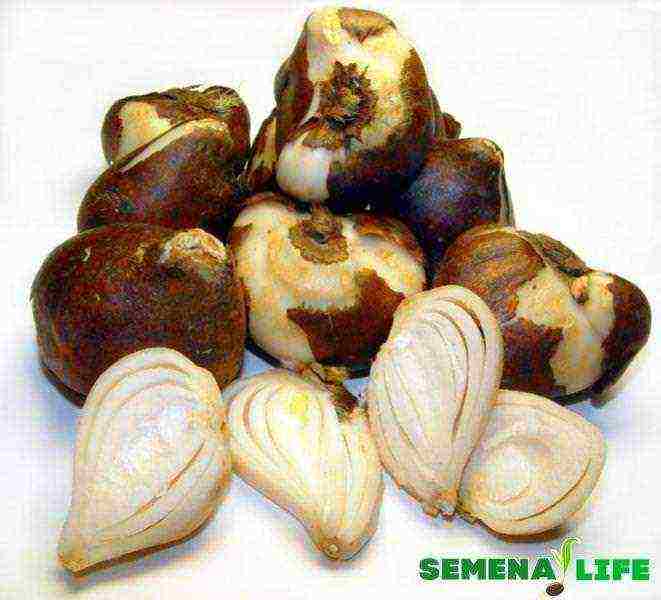
The first year, a weak bulb is not dug up, leaving it to winter in the ground. Starting next year, like all bulbous ones, they are dug up in the summer, dried well in a dark, dry room and stored until autumn. In the fall, the bulbs are planted in the ground.
If the seeds are grown in seedling containers, then they are not replanted until two years after sowing.
The best place for them is cold greenhouses.
Further care of seedlings
The bulbs obtained from the seeds are planting material that is already familiar to everyone and is handled as usual. As you know, hyacinths are planted in the soil in autumn, covered with a thick layer of straw or similar material.
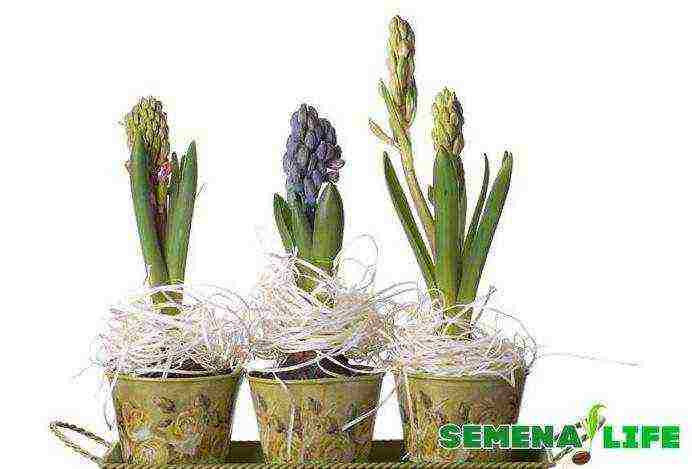
Before planting, the bulbs can be treated with a fungicide, after all, hyacinths are a little capricious and prone to disease. In the spring, after germination, the flowers must be fed.
It should be remembered that plants grown from seeds bloom only after 4-6 years - this is a long way that requires time and patience.
But on the other hand, the resulting hyacinths, as a rule, do not inherit maternal traits, that is, it is quite possible to obtain a completely new, unusual variety of a flower. This is what attracts breeders and enthusiastic gardeners to seed reproduction. If it is possible to grow a really new type of exquisite flower, then in the future it is propagated by the usual, bulbous method.
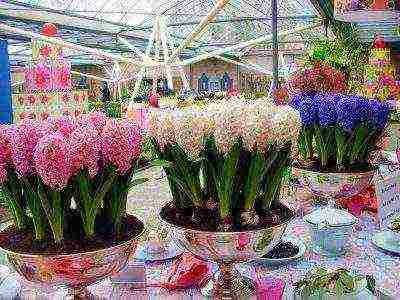
Hyacinth belongs to the lily family.
There are more than 30 types of various subspecies.
The flowers of the plant can be double, fragrant and simple.
Suitable for growing at home, garden plots, greenhouses and botanical gardens. The birthplace of the flower is Asia.
…
Growing hyacinths in pots
 How to grow hyacinths in pots?
How to grow hyacinths in pots?
The plant prefers bright, diffused light. Dislikes cold winds and drafts.
The soil should be loose, breathable. It is necessary to add humus to the substrate.
The tanks must have a drainage system that will not allow excess moisture to accumulate. For this, expanded clay, pebbles, shards or broken brick are suitable.
After flowering, the peduncle must be cut off. At the beginning of autumn, watering and feeding is reduced to a minimum.
At the beginning of winter, the plant begins a dormant period. At this time, the leaves shrink and die off. All nutrients are transferred to the onion.
ADVICE: At the beginning of spring, the soil is mulched with compost. Reproduction can be carried out during the same period.
Reproduction
Consider how to propagate hyacinths at home. There are four breeding methods.
Seeds
Reproduction of hyacinths at home using seeds should only be used for breeding new subspecies.
When planted with seeds, the plant will bloom only 6-9 years after planting.
How to grow hyacinth from seeds at home? It is best to tie the planting material in warm weather. It is necessary to select the boxes that have not yet opened.
 It is important that they are amber.
It is important that they are amber.
Emeralds are not recommended to be used, since they have not yet had time to ripen. A week after assembly, the boxes crack on their own.
The seeds are thoroughly dried and cleaned of scales. It is best to use paper bags. They must be stored in a cool room before sowing.
It is necessary to prepare containers with a substrate. Small grooves are made with a depth of no more than 2 cm.
If you sow the seeds deeper, they will not have time to sprout and will rot in the soil.
For 1 sq. about 200 seeds are sown per meter. Drainage and sand must be poured at the bottom of the container. This will keep the root system from rotting. In six months, the first shoots should be expected.
IMPORTANT: The seeds must have time to pass the vernalization stage. Sowing is done in early autumn. The first shoots will appear only in the middle of next spring.
By the end of the growing season, a small onion should appear. It is pear-shaped. During the entire growing period, the soil must be loosened, fertilized, ventilated, systematically watered.
ADVICE: For top dressing, you can use ammonium nitrate, potassium sulfate or superphosphates.
Bulbs
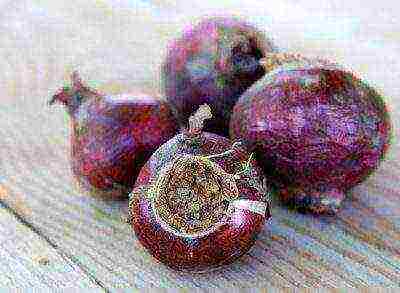 How to grow hyacinth from a bulb? One container with a diameter of 18-20 cm is allocated for each onion.
How to grow hyacinth from a bulb? One container with a diameter of 18-20 cm is allocated for each onion.
In the container, drainage is made from clay petioles. Fine-grained sea sand is poured at the bottom.
The soil should be fortified with plenty of nutrients.
The bulbs are planted in such a way that 1/3 remains on the soil surface. The planting depth should not exceed 4 cm. The soil must be loosened, fertilized and systematically watered.
Two years after planting, a full-fledged plant should grow. For 3 or 4 years of life, this representative of the flora blooms. During all active growth, the flower needs a temperature of 17-21 ° C. The room should be bright and well ventilated.
ADVICE: Diseased specimens must be removed.
Leaflets
 In the budding phase, this representative of the flora is allowed to propagate by leaves.
In the budding phase, this representative of the flora is allowed to propagate by leaves.
You can take 2 leaves from each flower. They are immediately dipped into the heteroauxin mixture. Half a tablet is diluted in 1 liter of water.
It is necessary to keep the leaves in the solution for 6-9 hours.
Then they are planted in containers with a substrate. The soil is mixed with fine-grained sea sand and peat.
ATTENTION: Growth should take place at a temperature of 14-16 ° C. Air humidity should not fall below 90%.
Callus should appear on the wound surface after 9-11 days. A month later, the first buds of bulbs appear. After 60 days, young new leaves and a root system should appear on the bulbs. After that, the flower must be transplanted into a nutritious, fortified soil.
One leaf can give from 7 to 10 children.
Double scales
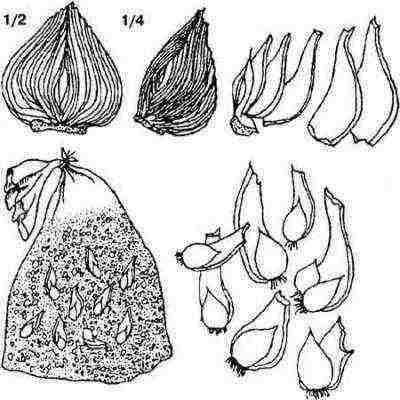 The bulbs are cleaned and dried. At the onion, it is necessary to cut off 1/3 of its height. After that, it is divided into 8 equal parts.
The bulbs are cleaned and dried. At the onion, it is necessary to cut off 1/3 of its height. After that, it is divided into 8 equal parts.
It is important that each piece retains a small piece of the bottom.
One large onion can produce up to one hundred paired scales. To disinfect the wounds of the planting material, it is necessary to use crushed charcoal.
Then the planting material is placed in cellophane bags with perlite. Perlite is pre-moistened with 1 drop of a mixture of foundazol. The bags are tied tightly.
ATTENTION: Storage should be carried out at a temperature of 23-25 ° C.
After 30 days, callus should appear on the cut line of the scales. It forms tubercles - new embryos of future bulbs. They must again be treated with a foundation and placed in plastic bags.
3-4 months after division, a root system should form in the planting material. Then each bulb is planted in a substrate of fine-grained sea sand. The containers are taken to a cold room.
ATTENTION: Growth should take place at a temperature of 9-13 ° C.
The substrate must be constantly moisturized. From time to time it is necessary to wait for the topsoil to dry out.
Useful video
You can clearly see how to properly propagate hyacinths in the video below:
How to grow hyacinths outdoors
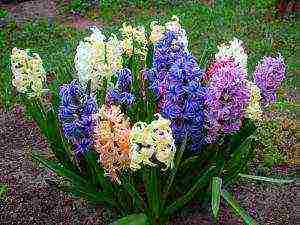
Hyacinth is a perennial bulbous plant popularly known as the rain flower.
Place and soil for growing hyacinths
Choose a site for growing hyacinths that is well-lit and calm. You can plant near shrubs or trees, but keep in mind that in the spring there will be enough sunlight for hyacinths, but if the nutrients are too close, it is a question, since trees and shrubs will pull them over. The area for hyacinths can be with a slight slope so that water does not stagnate on it, otherwise it can contribute to the occurrence of fungal diseases and rotting of the bulbs. The depth of groundwater should not be less than 50-60 cm to the soil surface. Otherwise, make a tall bed or drainage from expanded clay.
Soil for hyacinths you need light water permeable, with a good supply of nutrients. Fresh or slightly rotten manure is not suitable for top dressing. For acidic soil, liming is required to a pH of 6.5. Add river sand and peat to dense clay soil.
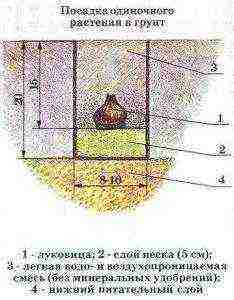 Planting hyacinths
Planting hyacinths
2 months before planting hyacinths in open ground (for the middle lane this is the end of September - beginning of November), prepare the soil, this is required in order to exclude the breakage of roots during possible subsidence of the soil. Under digging (40 cm), add humus to 1 sq. m 10-15 kg, peat, sand, 60-80 g of superphosphate, 30 g of potassium sulfate (replacing 200 g of wood ash), 15 g of magnesium sulfate (replacing 250 g of dolomite flour). If the soil is sandy, then increase the amount of potassium-magnesium fertilizers by 1.5 times. Apply nitrogen fertilizers in the spring. If humus or peat was not added during digging, then add it directly to the hole when planting.
Planting hyacinths earlier will provoke growth, because of which they will not overwinter. With a later planting of hyacinths in open ground, it is imperative to cover the site with leaves and protect it from rain, and return the shelter after planting. Select medium-sized bulbs for planting, the flower stalks will be more resistant to weather changes.
Large hyacinth bulbs (about 5 cm in diameter) are planted to a depth of 15-18 cm from the bottom to the soil surface, at a distance of 15-20 cm in a row. Smaller bulbs are planted smaller and denser.Make holes or grooves, "cover" the bottom with river sand with a layer of about 5 cm. Press the bulbs into it, cover it with sand, then soil to the end. This planting is ideal for hyacinth, since in this case the sand acts as a drainage, which will prevent the bulbs from rotting from waterlogging and protect against infection. Plant in damp soil, or water the planting if the soil was dry.
If you plan to grow hyacinths in the open field in large numbers, we recommend planting in high beds (15-20 cm) for easy hyacinth care (it is easy to set up a shelter, quickly warming up the soil in spring, protecting against waterlogging and supporting soil aeration). Make rows at a distance of 20-25 cm, plant the bulbs at a distance of at least three bulb diameters.
You can cover hyacinths in the garden before frost with dry peat, sawdust, spruce branches, humus. In early spring, remove the shelter, as flower sprouts appear very early.
 Feeding hyacinths
Feeding hyacinths
For hyacinths, feeding is one of the main ingredients in growing. In the spring, when most hyacinth sprouts appear in the open field, apply mineral fertilizers (per 1 sq. M. 20 g of ammonium nitrate, 15 g of superphosphate and 10 g of potassium chloride). When buds begin to appear, add 1 sq. m 20 g of ammonium nitrate, 40 g of superphosphate and 20-30 g of potassium chloride. Carry out the third dressing at the end of flowering (for 1 sq. M. 40 g of superphosphate and potassium chloride, without ammonium nitrate). Loosen the soil after each top dressing.
When fertilizers are applied in dry form, they are embedded in the soil, and when in liquid form, then the hyacinths are preliminarily watered and the dose of fertilizers is reduced.
Hyacinth care
Hyacinths prefer clean, weed-free soil around them. Loosen the soil regularly, starting from the emergence of shoots, the air regime of the plant is observed.
Watering hyacinths should be abundant to a depth of 15-20 cm, but not often. Watch the soil moisture especially during the budding period.
If diseased hyacinths appear, remove and burn them.
When the hyacinths have faded, cut off the peduncle with a knife, you can only remove the faded flowers (run your hand over the plant from the bottom up, what falls off will fall off, leave the rest).
 Digging hyacinths
Digging hyacinths
Digging hyacinths gives a lot of positive aspects: it improves flowering, you can examine the bulbs for damage by diseases and pests and carry out processing, select healthy children for growing.
Hyacinths are dug in late June - early July, when the leaves of the plants turn yellow and begin to deform. In this case, most of the nutrients will go to the development of the bulb. At a later digging, when the ground part of the plants disappears, it will be quite difficult to find the bulbs without damaging them, and the flowering will, as a rule, be weaker. After digging, cut off the leaves of the plants, clean the soil, and dry in a small draft in a dark room for 5-7 days (drying temperature 20 ° C). Next, clean the bulbs from the roots, detachable scales and formed children (do not separate small children).
Storage of hyacinths
Storing hyacinths is different from storing daffodil or tulip bulbs. During storage of hyacinths, a flower is formed. For storage and distillation of hyacinths, sort (by size and type) and leave only the healthiest samples, put in storage boxes in no more than 2 layers. Store the bulbs for 2 months at a temperature of 25-26 ° C, then transfer them to a room with a temperature of 17 ° C for 1 month, no more. Keep the air humidity high, as the bulbs can dry out when low. You can correct the situation by periodically sprinkling the bulbs with water.
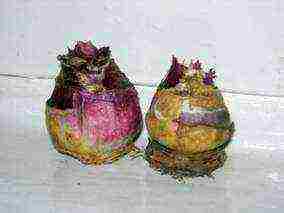 During storage, very often the bulbs form a large number of small children, so be extremely careful when planting hyacinths. Moreover, such bulbs need to be planted at a depth of half the usual depth, after which the planting should be covered with mulch.Growing up a baby lasts 4-5 years. If you want to specifically call a large number of children (for reproduction by children), then after digging out the hyacinth bulbs, wipe the bottom of the bulb thoroughly with a dry cloth so as to remove all roots (do not cut off).
During storage, very often the bulbs form a large number of small children, so be extremely careful when planting hyacinths. Moreover, such bulbs need to be planted at a depth of half the usual depth, after which the planting should be covered with mulch.Growing up a baby lasts 4-5 years. If you want to specifically call a large number of children (for reproduction by children), then after digging out the hyacinth bulbs, wipe the bottom of the bulb thoroughly with a dry cloth so as to remove all roots (do not cut off).
Vault rot in hyacinths it occurs as a result of such factors: storage of damaged bulbs at high air humidity and low temperatures (below 17 ° C). Determine the disease by the dry ends of the roots, a cut of scales near the bottom of a light brown color. Peduncles after planting slow down growth and break. Therefore, plant those bulbs whose roots have grown ahead of time without waiting for the others, and during storage observe all the necessary modes: temperature, humidity and ventilation.
Hyacinths propagate seeds, children (natural and artificial reproduction).
Seed method of propagation of hyacinths for gardeners-breeders, it makes it possible to develop new varieties, since new young seedlings do not repeat the parental species characteristics. The flowering of seedlings begins in 5-7 years. Hyacinth seeds are sown in seedling boxes in late September. The soil for sowing is as follows: 2 parts of humus, 1 part of leafy soil and 1 part of sand. It is grown in cold greenhouses for 2 years.
 Reproduction of hyacinths by children goes slowly, since in one year the bulb can give only 1-2 babies, sometimes more. If the children are not separated from the bulb badly, then they do not need to be specially broken off for growing. Plant the bulb with the children. It happens that during storage many babies are formed near the bottom (we wrote about this above), then you need to carefully plant such bulbs for growing.
Reproduction of hyacinths by children goes slowly, since in one year the bulb can give only 1-2 babies, sometimes more. If the children are not separated from the bulb badly, then they do not need to be specially broken off for growing. Plant the bulb with the children. It happens that during storage many babies are formed near the bottom (we wrote about this above), then you need to carefully plant such bulbs for growing.
For mass cultivation of hyacinths use artificial propagation methods to bring out as many flowers as possible in a short time. Bulbs with a diameter of 5 cm and a weight of 80-100 g can be propagated by cutting and notching the bottom. In any case, the mother's bulb is injured here, followed by its death. Hyacinth bulbs are disinfected in a 1% solution of potassium permanganate and dried for 2 days at a temperature of 20-23 ° C.
Method for breeding hyacinths by cutting out the bottom
Using a teaspoon with a sharp edge (not a knife), cut out the bottom without injuring the middle. Check that the bases of all scaly leaves have been removed. Treat the sections with a fungicide to prevent disease. Place the bulbs in boxes or on a wire mesh or dry sand surface with the cut side up. Now for 2-3 months in this position, the bulbs are stored at a temperature of 21 ° C for the formation of young bulbs on the slices (one bulb will give 20-40 children with a diameter of 0.5-1.0 cm).
Plant the bulbs with the babies in the same position in the pot so that the babies are just a little covered with the soil mixture. Temper the plants, then move them to a cold greenhouse. In the spring, the babies will give leaves and grow, taking strength from the mother's bulb. When the growing season comes to an end, the bulbs are dug up and planted. Flowering begins in 3-4 years.

Method for breeding hyacinths by notching the bottom
This is an easier way of reproduction, with fewer babies (8-15 pcs), but with a larger diameter, which will begin flowering in 2-3 years.
Disinfect the bulbs with 1% potassium permanganate solution. Use a sharp knife to cut the bottom of the mother bulb to a depth of 0.5-0.6 cm: on large bulbs, 4 cuts at right angles to each other (2 criss-cross), on small bulbs, 2 cuts are enough. After the "operation", place the bulbs for a day in a dry room with a temperature of 21 ° C to open the slices. Treat the sections with a fungicide and proceed according to the previous scheme.
The same breeding methods can be used for daffodils and muscari.
You can grow hyacinths in pots in a prikop, extending the flowering period
The aroma of hyacinths can be heard already in mid-April, at this time the flowers begin to bloom their inflorescences. If hyacinths are planted in a sunny area, then in warm spring they will fade very quickly. If you plant hyacinths in a slightly shaded place, then flowering will last a little longer. You can grow hyacinths in pots and adjust the flowering time yourself.


Usually, containers are used for planting flowers: pots, tubs, bowls, boxes, etc. All these containers with flowering plants can be displayed on the windowsill, and in spring they can be placed in the foreground of the garden, flower beds, pots, decorating "artificially" your summer cottage landscape. This flower arrangement of hyacinths will perfectly decorate any container, even a basket.
The period for planting in pots in the buried hyacinths is the same as for planting in open ground, i.e. about the month of October. Dig a trench in an open area to maximize the sun's rays in the winter. Length and  the width of the trench depends on the size and number of containers, but the depth should be such that there is another 15 cm from the top edge of the containers to the surface of the ground.After planting the hyacinth bulbs in a pot, wrap it with something to protect the pot from dirt and hypothermia (even newspapers). Place the hyacinth pots in the trench, lay a layer of fallen
the width of the trench depends on the size and number of containers, but the depth should be such that there is another 15 cm from the top edge of the containers to the surface of the ground.After planting the hyacinth bulbs in a pot, wrap it with something to protect the pot from dirt and hypothermia (even newspapers). Place the hyacinth pots in the trench, lay a layer of fallen  foliage, dig in with earth and lay a layer of foliage again. This will protect the bulbs from the cold.
foliage, dig in with earth and lay a layer of foliage again. This will protect the bulbs from the cold.
To speed up the onset of flowering hyacinths in pots at the beginning of March, remove the containers from the trench (not all! To extend the flowering time.) and transfer to a warm place, the plants respond well to heat (the arrows will immediately grow). Potted hyacinths will start blooming at the end of March!
Blooming and fragrant hyacinths in pots can be left at home, taken out to a glazed balcony, and in good weather for a day in the garden (at night, bring back to warm or leave in the garden, but cover with spunbond).
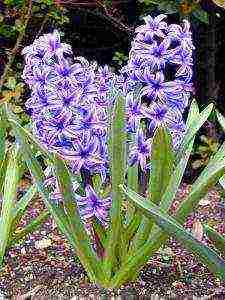 To advance the flowering dates of hyacinths in pots in mid-March, remove the containers from the trench (not all!) and transfer them not to heat, but to a cool place, basement or cellar. Inspect the plants regularly and water them. In mid-April, move the hyacinth pots to a warmer place and gradually expose them to a brighter light. Thus, the blooming of hyacinths will begin only in late April - early May!
To advance the flowering dates of hyacinths in pots in mid-March, remove the containers from the trench (not all!) and transfer them not to heat, but to a cool place, basement or cellar. Inspect the plants regularly and water them. In mid-April, move the hyacinth pots to a warmer place and gradually expose them to a brighter light. Thus, the blooming of hyacinths will begin only in late April - early May!
When potted hyacinths begin to bloom, remove the next batch of containers from the trench, so you and others can admire the beautiful flowers for longer.
Taking care of potted hyacinths is much more difficult. It requires regular feeding and moderate watering. Dig up the bulbs when the foliage of the plants is completely yellow (around the end of June). Peel the bulbs from the soil and store in a dry place until planting in the fall. If the bulbs are not dug out, the next flowering will be weaker.
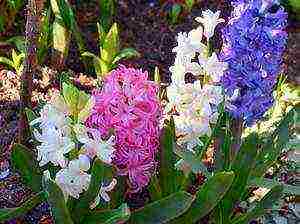 Hyacinth is native to North Africa, the Mediterranean and the Middle East. It belongs to the genus of bulbous perennial herbs of the Asparagus family. From the ancient Greek language "hyacinth" is translated as "rain flower".
Hyacinth is native to North Africa, the Mediterranean and the Middle East. It belongs to the genus of bulbous perennial herbs of the Asparagus family. From the ancient Greek language "hyacinth" is translated as "rain flower".
Flowers bloom at the very beginning of spring and amaze with a riot of different colors and a fragrant aroma. The plant can be grown not only outdoors in the garden, but also at home.
Description of hyacinth
 The plant gained great popularity thanks to the Netherlands, which received the name "Hyacinth center"... It is in this country that breeders have bred a large number of varieties and hybrid forms of a flower, the bulbs of which are exported annually to other countries.
The plant gained great popularity thanks to the Netherlands, which received the name "Hyacinth center"... It is in this country that breeders have bred a large number of varieties and hybrid forms of a flower, the bulbs of which are exported annually to other countries.
The plant bulbs have a dense structure, represented by succulent grassy leaves. The stems, flowering from the bottom, grow up to 30 cm. In the lower area of the shoots there are narrow, upwardly directed leaves. In the corner of the top plate formed a kidney from which the bulb is then transformed.Such a bulb blooms next year. Perhaps the formation of small bulbs in other leaves, which trimmed and used for subsequent vegetative propagation of the plant.
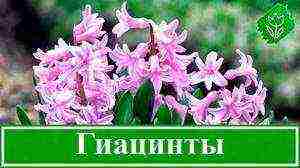 Carpal inflorescences, located at the top, consist of flowers collected in a cone-shaped or cylindrical shape. Perianths are bright bell-shaped funnels with bent blades.
Carpal inflorescences, located at the top, consist of flowers collected in a cone-shaped or cylindrical shape. Perianths are bright bell-shaped funnels with bent blades.
Hyacinths are characterized by wide palette... Flowers can be white, yellow, orange, pink, purple, red, blue. They come in simple and terry shapes. Three-nested fruits have two seeds with a delicate skin in each nest.
Features in the cultivation of hyacinths in the open field
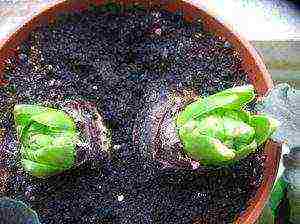 Like all plants, hyacinth is characterized by certain requirements in agricultural technology. The perennial is a moody flower.
Like all plants, hyacinth is characterized by certain requirements in agricultural technology. The perennial is a moody flower.
If you decide to decorate the garden of your summer cottage with this particular type of plant, then you need to learn how to grow hyacinths correctly and when to plant.
Correct conditions for good flower development:
- The soil for the plant should be neutral. The ideal substrate would be a mixture of turf and leafy soil in equal proportions. With high acidity of the soil, liming is necessary; peat or river sand is added to clay soil.
- A loose substrate requires excellent drainage to protect the flowers from waterlogging.
- The area for hyacinths in the garden is selected warm and sunny.
- There should be no strong winds or drafts in the place where the flowers are grown. It is not uncommon for gardeners to plant plants next to shrubs and trees, which protect the flowers from gusts of air.
- Fresh organic matter is prohibited for this perennial.
Hyacinths: planting and care in the open field
 Bulbs for planting are selected elastic and large; their diameter should be at least 4 cm. Samples with mechanical damage, mold, diaper rash and lethargy are immediately excluded. A quality bulb is characterized by two millimeter root buds.
Bulbs for planting are selected elastic and large; their diameter should be at least 4 cm. Samples with mechanical damage, mold, diaper rash and lethargy are immediately excluded. A quality bulb is characterized by two millimeter root buds.
Such specimens will be able to fast take root, as well as successfully transfer the winter period and bloom profusely next year. In spring, hyacinths are not planted.
How to plant hyacinths
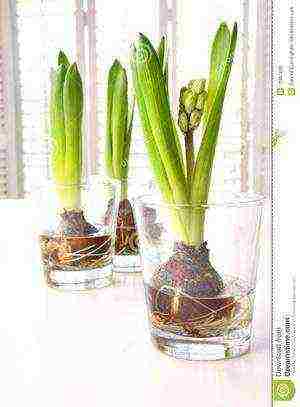 Experienced gardeners advise do not plant hyacinths too close to trees or shrubs, which can absorb a large amount of nutrients from the ground and leave nothing to flowers.
Experienced gardeners advise do not plant hyacinths too close to trees or shrubs, which can absorb a large amount of nutrients from the ground and leave nothing to flowers.
Prepare the soil for planting the bulbs in advance. They dig it up at a depth of 35–40 cm. The following amount of fertilizer must be applied to 1 square meter of the beds:
- Superphosphate - 70-80 g;
- Magnesium sulfate - 15 g;
- Potassium sulfate - 30 g;
- Fresh compost (or humus) - 10-15 kg.
Limestone is introduced into acidic soil, and peat or river sand into clayey soil. For sandy areas, you should increase the feeding with magnesium and potassium 1.5-2 times.
Large bulbs should be planted 25–30 cm away from small ones. The depth of the hole should be at least 15-16 cm. The larger the bulb, the deeper it should be. If the small bulbs are too low in the soil, then they will not be able to grow out.
Planting hyacinths in autumn
 Optimal period for growing the plant will be the period from late September to early October.
Optimal period for growing the plant will be the period from late September to early October.
If you plant seed before these dates, then they will quickly grow and die in winter. And with planting in late autumn, the plants will not have time to take root until the winter frosts.
The bulbs selected for planting are treated in a solution fungicide within 30-40 minutes. Such treatment contributes to better rooting and high resistance of plants to bad weather.
The planting depth for bulbs ranges from 15–20 cm. The distance between the bulbs should be 15–20 cm, and between the rows - 25–30 cm.
 Hyacinth grows well on sand. Clean river sand is poured onto the bottom of the holes in a layer of 4–6 cm and gently pressed into it landing material that is covered with the remaining sand, and then earth. The dry substrate is watered with water. This planting method does not allow moisture to linger in the soil, which leads to a decrease in the risk of rotting of the bulbs.
Hyacinth grows well on sand. Clean river sand is poured onto the bottom of the holes in a layer of 4–6 cm and gently pressed into it landing material that is covered with the remaining sand, and then earth. The dry substrate is watered with water. This planting method does not allow moisture to linger in the soil, which leads to a decrease in the risk of rotting of the bulbs.
For flowering acceleration the hyacinth should be planted in tall beds that warm up quickly in the sun.
In temperate latitudes, planting bulbs can be done late in the fall, in the first half of November, when there is still no strong frost. The process of growing flowers before winter includes the obligatory mulching of the soil with peat, sawdust, foliage or spruce branches. The shelter is removed in early spring so that it does not damage the developing seedlings.
Flower care
Hyacinth care after planting consists of the following activities:
 Loosening... The plant requires regular loosening. To facilitate the process of work, after planting, be sure to mulch the soil.
Loosening... The plant requires regular loosening. To facilitate the process of work, after planting, be sure to mulch the soil.- Weed control... Hyacinth is a clean plant, therefore it is necessary to promptly remove weeds and other herbs that interfere with the normal development of the flower.
- Watering... The hyacinth should only be watered during dry periods. The soil should be moistened at the level of 20-25 cm deep. Since the plant blooms in the spring months, it does not need watering: the snow that has melted after winter moisturizes the soil sufficiently so that the flowers fully open and fill the air with a pleasant aroma.
- Top dressing... Fertilizing the flower is an important part of caring for it. Hyacinth needs three additional feeding during the growing season. With the appearance of the first shoots, 30 g of ammonium nitrate per 1 square meter are introduced into the soil. The second feeding is done during the coloring of the buds. For the same area, you will need 25 g of ammonium nitrate, 30 g of potassium chloride and 35 g of superphosphate. At the end of flowering, 35–40 g of superphosphate is added to the soil. Top dressing followed by watering should be applied to the ground between rows or flowers.
With proper planting and care of hyacinths, abundant flowering of the plant will be guaranteed.
Hyacinth care after the growing season
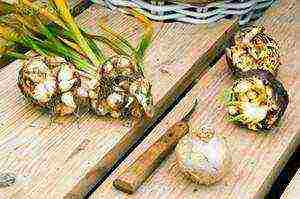 After a bright and lush bloom, hyacinths need transfer, which will help them to survive and bloom in a new way next year.
After a bright and lush bloom, hyacinths need transfer, which will help them to survive and bloom in a new way next year.
At the end of the growing season, the flowers are left for 2-3 months to recuperate after flowering... To make the bulbs quickly recover and get stronger, nitrogen-containing fertilizers are applied for them once every 1-2 weeks.
 After a dormant period, the bulbs are dug up. The procedure must be completed after yellowing leaves. First, the yellow stems are cut and then the bulbs are dug up.
After a dormant period, the bulbs are dug up. The procedure must be completed after yellowing leaves. First, the yellow stems are cut and then the bulbs are dug up.
The material is cleaned of the earth, the diseased specimens are thrown away, and the healthy ones are washed, dried and treated with special solutions. The bulbs are then planted in separate containers with the substrate. The containers are transferred to premises with a constant temperature within + 16-19 degrees.
Ventilate regularly throughout the week to allow the bulbs to breathe. During this time, the material acclimatized and will be ready for the next stage of storage. The room temperature is increased to + 28-29 degrees; humidity should be high. A month before transplanting into open ground, the temperature is again lowered to +16 degrees, so that the plant has time to harden and prepare for re-growing in outdoor conditions.
Growing hyacinth from seeds
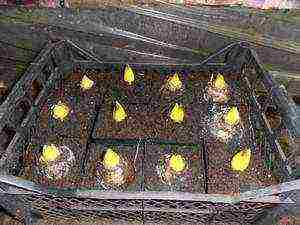 The plant is usually propagated children, bulbous scales or cutting the bottom... The seed method is longer and more laborious. Hyacinth, propagated by seeds, should be grown according to the same rules, but it does not bloom until a few years later. Therefore, this method of flower propagation is chosen only by experienced and patient gardeners.
The plant is usually propagated children, bulbous scales or cutting the bottom... The seed method is longer and more laborious. Hyacinth, propagated by seeds, should be grown according to the same rules, but it does not bloom until a few years later. Therefore, this method of flower propagation is chosen only by experienced and patient gardeners.
The procedure is performed in September. To do this, take small containers with a light, loose substrate, for the preparation of which they take leafy earth, humus and river sand. Seedlings are grown in cool greenhouse during two years. Seedlings bloom in 5–7 years, without inheriting the varietal traits of their parents.
Usually this method is used by breeders for breeding new varieties and hybrids... Novice gardeners and amateurs are advised to choose methods of reproduction by children and cutting out the bottom.
Pests and diseases
Hyacinths have high stability to diseases. But with the wrong conditions of detention, they can be exposed to:
 Yellow bacterial rot... Bacterial disease is characterized by the appearance of unpleasant-smelling mucus on the bulbs. The disease is manifested by the plant lagging behind in growth, spots and stripes on the peduncles and leaves. Affected plants are dug up and burned, and the holes are treated with bleach.
Yellow bacterial rot... Bacterial disease is characterized by the appearance of unpleasant-smelling mucus on the bulbs. The disease is manifested by the plant lagging behind in growth, spots and stripes on the peduncles and leaves. Affected plants are dug up and burned, and the holes are treated with bleach.- Gray rot... A fairly common fungus is expressed in small yellowish spots on the leaf plates, which then begin to turn brown and grow larger. If the symptoms are not noticed in time, the disease will spread to the bulb, which will completely rot. When the flower is at the initial stage of the disease, it is sprayed with a solution of Fundazole or Euparen.
- Penicillous rot... Fungal disease manifests itself in the form of plaque on the aerial parts, which leads to decay of the plant and drying out of the flowers. For the treatment of hyacinth, copper-containing preparations are used.
- Falling inflorescences from the outlet... Although this is not an infectious disease, it often happens to the plant if watering is done in large quantities or the temperature at which the bulbs were stored was too low.
Among insect parasitesthat can occupy flowers, it should be highlighted:
 Flower fly. The flower fly larvae eat the bottoms of the bulbs. You can destroy them with Mukhoed, Aktara or Tabazol.
Flower fly. The flower fly larvae eat the bottoms of the bulbs. You can destroy them with Mukhoed, Aktara or Tabazol.- Medvedka. The insect feeds on the underground organs of the flower. Mulching the soil will help fight these pests.
- Root onion mite. This pest eats bulbs, making moves to the buds and inflorescences and destroying them. Minor injuries are treated with Rogor or Karbofos.
- Stem nematode. This parasite deforms all parts of the plant (wrinkles leaves, bends flower stalks). The stem nematode delays the development and flowering of the hyacinth. Sometimes the plant dies. The bulbs should be dug up; specimens that cannot be cured are thrown away, and the slightly affected material is steamed in warm water for several hours.
If you properly care for the hyacinth and follow all the rules for planting and transplanting plants, then you can achieve a bright and lush garden with fragrant flowers that will delight you with a variety of colors every spring.

